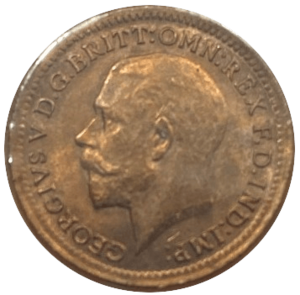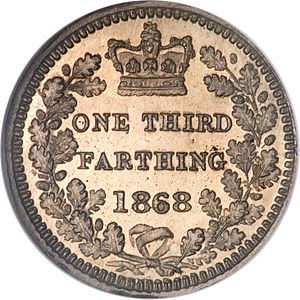Third farthing facts for kids
| United Kingdom | |
| Value | £0.0003472 0.083d |
|---|---|
| Mass | (1827–1844) 1.5–1.6 g (1866–1913) 0.9–1 g |
| Diameter | 16 mm |
| Composition | (1827–1844) copper (1866–1913) bronze |
| Years of minting | 1827, 1835, 1844, 1866, 1868, 1876, 1878, 1881, 1884, 1885, 1902, 1913 |
| Obverse | |
 |
|
| Design | Profile of the monarch (George V design shown) |
| Designer | Bertram Mackennal |
| Reverse | |
 |
|
| Design | Various (Crown-and-oak-wreath design shown) |
| Designer | Leonard Charles Wyon |
| Design date | 1866 |
The one-third farthing was a small British coin. It was worth a tiny part of a pound, about 1⁄2880 of it! To help you imagine, it was also 1⁄12 of a penny.
This coin was made from copper in 1827, 1835, and 1844. Later, it was made from bronze between 1866 and 1913. Even though it was a British coin, it was mostly used in the Crown Colony of Malta. Malta used British money, so the one-third farthing helped people make small payments there.
Contents
History of the One-Third Farthing
When Malta became a British protectorate in 1800, it meant Britain protected and partly controlled the island. At that time, Malta used its own money called the Maltese scudo. This scudo was divided into 240 smaller bronze coins called grani. People in Malta often called a grano (and later the one-third farthing) a ħabba, which means "grain."
Why a New Coin for Malta?
In 1825, British money became the official currency in Malta. The smallest British coin, the farthing, was worth three grani. This meant there was no British coin small enough to replace the grano.
So, on November 3, 1827, British officials announced a plan. They said a new copper coin, even smaller than the farthing, was needed for Malta. This new coin would help people pay for very small things.
The First One-Third Farthings
The Royal Mint, which makes British coins, created 1,440,000 one-third farthings. These coins were also called "British grains" because they replaced the old grani. Even though they were British coins, they could only be used in Malta. They were not accepted as money in the United Kingdom itself.
The Governor of Malta wanted the coins to say "MALTA - ONE GRAIN." However, the mint decided to use designs already made for the British farthing.
Early Designs (1827-1844)
The first one-third farthings had a picture of George IV on one side (called the obverse). This side also showed the year the coin was made. The other side (called the reverse) showed Britannia, a symbol of Britain. She was seated with a shield and a trident. This design was created by William Wyon.
These early coins were made of copper. They weighed about 1.5 to 1.6 grams and were 16 millimeters wide. New copper coins with the same size and weight were made in 1835 and 1844. These newer coins featured portraits of William IV and Queen Victoria, respectively.
Bronze Coins and New Designs (1866-1913)
In 1866, the one-third farthing started to be made from bronze instead of copper. These bronze coins were lighter, weighing about 0.9 to 1.0 gram, but kept the same 16-millimeter width.
The coin's design also changed. The front (obverse) showed a picture of Queen Victoria wearing a laurel wreath. The back (reverse) was redesigned to clearly show the coin's value and the date. This side was surrounded by a wreath of oak leaves and a royal crown. Both of these new designs were created by Leonard Charles Wyon. These designs were used for later coins featuring Victoria in 1868, 1876, 1878, 1881, 1884, and 1885.
In 1902, 288,000 one-third farthings were made for Edward VII. The front had a new portrait by George William de Saulles. The back used an updated version of L. C. Wyon's crown-and-oak-wreath design, but with an imperial crown. The very last one-third farthings were made in 1913 for George V. The front featured a portrait by Bertram Mackennal, while the back reused the 1902 design.
End of an Era
Even though British money was used in Malta until 1972, the one-third farthing seems to have stopped being used by the 1930s.
In 2015, the Central Bank of Malta honored this small coin. They released 2,500 special €5 gold commemorative coins. The front of these new coins showed the date and emblem of Malta. The back was inspired by William Wyon's original seated-Britannia design from the 1827, 1835, and 1844 one-third farthings.

